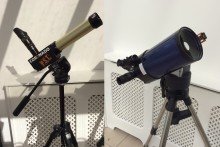This week we’ve got a different take on astronomy. I recently sent out a simple questionnaire to some fellow astronomers, so as to better reflect here the diversity that exists within the interest. My ‘thing’, for example, is DSOs (deep space objects) – galaxies, nebulae, etc. (commonly known as ‘faint fuzzies’). Others, however, are drawn to observing objects closer to home: planets, the moon, and even the sun; and a great many specialise in astrophotography rather than visual observing, and that’s a whole other discipline …
We all have different preferences when it comes to equipment, too. Whereas I’ve gone for aperture with my gear (and therefore increased light gathering capabilities for faint objects), others go for focal length (magnification), smaller size for ease of storage/transportation, or even for specialised telescopes for solar observing … The first of my ’guest astronomers’ is Max Griffith, a fellow resident of Cerne Abbas:
Twitter handle / website / blog address: NA
How, when and why did you get in to astronomy in the first place?: I started to experiment with lenses as a teenager. It became a fascination, and eventually, having saved enough pocket/birthday/Christmas money, when aged 15, l built an 8.5in, f/7.5 Newtonian on a German equatorial mount.
What’s your setup (what equipment do you have)?: Nowadays I have a Meade ETX 125 Maksutov-Cassegrain, a Coronado PST, a Kowa 20-60 x 82 spotting scope, 8 x 56 binoculars, plus various mounts and tripods, including Gitzo, Manfrotto and an iOptron Mini Tower II.
Do you specialise in a particular area?: The Sun. The Moon, Jupiter, Saturn and Mars are also worth attention if it’s not too cold!
Most memorable ‘wow moment’?: Without a telescope on 21 July 1969 at 3am. I stood on the lawn and waved to Neil Armstrong on the Moon! I knew I could see him but had to check our black and white television to see if he waved back – maybe he was preoccupied!
When were you last out and what did you see?: Today. The Sun – our nearest star.
Favourite bit of kit: Coronado PST. So safe, quick, easy and light. Endlessly reveals each unique day on the Sun.
What does astronomy give to/do for you?: Inexplicable objects within incomprehensible infinity. Transported by astronomy our journey discovers more and more conundrums. Our minds are teased to mull the human place in all of this.
Further comments: When young I looked at everything but the older I get the more I like the sun!
Thanks to Max for taking the time to fill in my questionnaire. I can confirm the amazing views of the sun given by his PST Coronado; and the Meade, with it’s 1900mm focal length (incredible for such a short scope), gives incredible views of the moon and major planets.
What’s up?
The Andromeda galaxy (M31) is ideally placed for observing at the moment (not so high that it’s a pain in the neck, not so low to be obscured by the murk in the atmosphere). A moderate pair of binoculars show it as an elongated cloud, whilst a telescope will also reveal its two satellite galaxies (M32 and M110). Roughly 40 degrees above the horizon at 10PM, and pretty much due east, it should be a fairly easy find.
It’s easy to take Andromeda for granted, and perhaps dismiss it when out observing. After all, it’s easy to find, and it’s big and fuzzy, with usually little or no detail. I always take the time to have a look, though. Sometimes there’s a hint of the dark dust lanes that surround the galaxy, and even perhaps the suggestion of a spiral arm. At the end of the day, of course, it’s a whole other galaxy, and that, for me at least, really fires the imagination.
Toward the end of September there’s a total lunar eclipse. In the early hours of the 28th the full moon will be eclipsed by the Earth’s shadow. Should be a dramatic sight!
Clear skies!
Kevin Quinn is an amateur astronomer based in Cerne Abbas, he is the proud owner of a ten-inch reflector and a hefty pair of binoculars. He tweets via @CerneAstro, blogs via theastroguy.wordpress.com, and his book ‘Demystifying Astronomy – A beginner’s guide to telescopes, eyepieces and accessories for visual astronomy’ is widely available.
©Kevin Quinn







